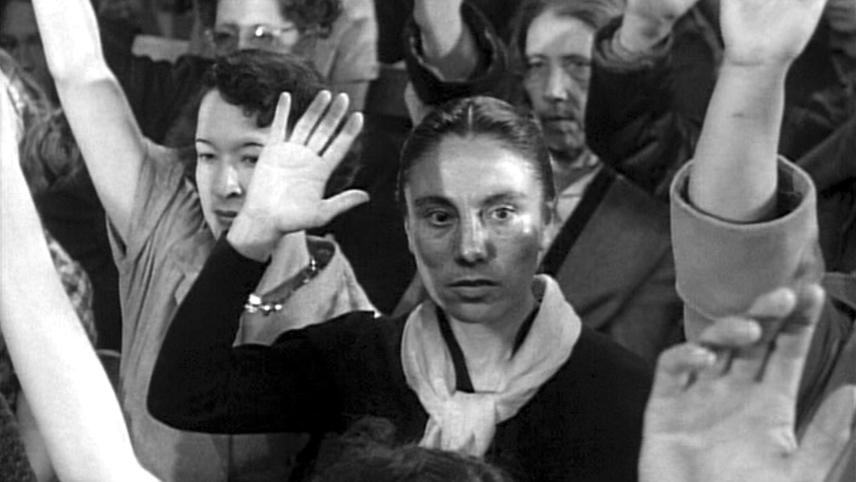
18 February 2015 20:00, Bozar Cinema, Brussels.
Noël Burch in conversation with Stoffel Debuysere, preceded by a screening of Red Hollywood (Thom Andersen & Noël Burch, 1996-2013, 120’)
“To the mass of filmgoers, after all, what is in focus is, indeed, the diegesis, the illusory “world experience” of film. The work of the signifier, however sophisticated, so long as it keeps a low profile, so long as it does not draw a curtain of semantic noise between that “world beyond the screen” and the “average spectator,” is invariably so out of focus as to be quite invisible.”
At a time when corporatists and politicians alike all seem to have a copy of Ayn Rand’s Atlas Shrugged on their nightstand, at a time when her self-styled brand of “radical capitalism” is promoted as a revolutionary and emancipatory force to be reckoned with (after all, aren’t the unreasonably persecuted one-percenters ultimately the symbol of a free society?), it’s pretty daunting to watch her demented testimony before the House Committee on Un-American Activities in 1947. Fulminating against the Hollywood movie Song of Russia – a bland melodrama about a symphony conductor who visits the Soviet Union, falls in love and joins the anti-Nazi resistance – Rand refuses to see the film in relation to the wartime alliance and furiously dismisses it as communist propaganda, because it shows too many Russians “smiling”. This is just one of the many scenes in Thom Andersen & Noël Burch’s Red Hollywood that illustrate the anti-communist hysteria in the throes of Mccarthyism. But who remembers the victims of the Hollywood blacklist, even the notorious “Hollywood Ten” who paid time for their refusal to give in to the coercion? In their film, Andersen and Burch reconstruct this faded period in the history of American cinema and give these screenwriters and filmmakers their due, not by simply confirming their historical status as non-talented martyrs or rejecting the allegations of the witch hunters, but by suggesting how they were actually able to express their ideas in the films they wrote and directed. The film recasts some of the arguments that Thom Andersen already made in his groundbreaking essay ‘Red Hollywood’ from 1985 and that he expanded upon in the book Les communistes de Hollywood. For the making of both the book and the film Andersen found a natural ally in Noël Burch. After all, who else could match the historical knowledge and aesthetical insight of this fellow dissenter? Ever since his Praxis du Cinéma (1969), Burch has explored – both in his writings and films – the cinematic tension between presentation and representation, statement and articulation, showing and telling, a tension that at one time used to be designated as “ideological”. The heyday of ideology critique may be long past by now, but some of its underlying questions keep on lingering today, not in the least in regards to the relation between appearance and reality, form and politics. To paraphrase the beautiful title of one of Burch’s books: how do we give life to those shadows? This Dissent! Session will take the ventures of the “left front” in Red Hollywood as a starting point to address this stubborn conundrum.
On 19 February Noël Burch will also present ‘The Forgotten Space’, a film he made with Allan Sekula, at KASKcinema.
DISSENT ! is an initiative of Argos, Auguste Orts and Courtisane, in the framework of the research project “Figures of Dissent” (KASK/Hogent), with support of VG.
——————————————————————————————————————————————————————-
About DISSENT!
How can the relation between cinema and politics be thought today? Between a cinema of politics and a politics of cinema, between politics as subject and as practice, between form and content? From Vertov’s cinematographic communism to the Dardenne brothers’ social realism, from Straub-Huillet’s Brechtian dialectics to the aesthetic-emancipatory figures of Pedro Costa, from Guy Debord’s radical anti-cinema to the mainstream pamphlets of Oliver Stone, the quest for cinematographic representations of political resistance has taken many different forms and strategies over the course of a century. The multiple choices and pathways that have gradually been adopted, constantly clash with the relationship between theory and practice, representation and action, awareness and mobilization, experience and change. Is cinema today regaining some of its old forces and promises? Are we once again confronted with the questions that Serge Daney asked a few decades ago? As the French film critic wrote: “How can political statements be presented cinematographically? And how can they be made positive?”. These issues are central in a series of conversations in which contemporary perspectives on the relationship between cinema and politics are explored.